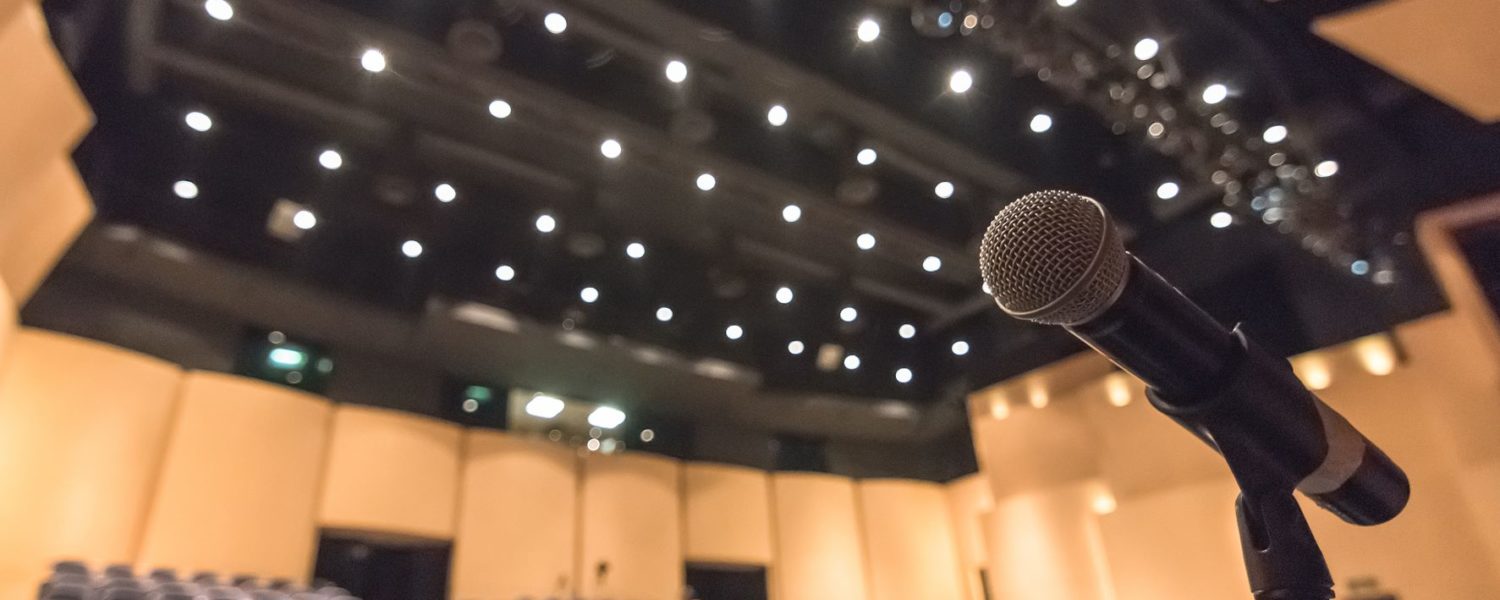By Chad Filipiak
Every large and small venue will need some level of sound amplification. While microphones are readily available, the options can be overwhelming. In this article, we will do our best to lay out how to select the right microphone, where to place the microphones and how to find the right balance to get the best sound before feedback.
SELECTING THE RIGHT MICROPHONE
Selecting the right microphone is one of the most common topics for a sound system. A microphone should last 10+ years, be easy to use and have multiple applications. Let’s discuss some of the options and terms you will see in your research.
Dynamic or Condenser
A dynamic microphone is typically used for a vocalist with a handheld microphone close to their mouth. They are also used for louder percussion instruments. A condenser microphone is more sensitive and typically used for a vocalist, either handheld, on a stand or on a lectern. They are also popular for amplifying choirs or picking up instruments from overhead.
Omnidirectional, Cardioid or Super Cardioid
An omnidirectional microphone is normally used in recording and not in a live setting because it goes into feedback quickly by picking up sound from all directions. A cardioid microphone picks up sound in the shape of an apple with the stem being the microphone handle. It will pick up sound directly in front of the microphone (on-axis) and on the sides of the microphone (off-axis) but reject sound from behind, allowing for multiple vocalists to surround the microphone. A super cardioid microphone also rejects sound from behind but picks up sound in a narrow field on-axis with greater distance, allowing for vocalists to be directly in front of the microphone but farther away.
Wireless Frequency
The frequency ranges used for wireless microphones can be crowded with TV stations and other users. Before selecting a range for your microphones, you will want to do an RF scan of your venue. Once you know what is available, you will still want to spread out the frequencies you use, so that your microphones do not interfere with each other.
PLACING THE MICROPHONES CORRECTLY
Now that you have the right microphone, you will want to make sure you are using it correctly. The direction and distance that a microphone picks up sound will determine where you place the microphones for people or instruments. For example, a cardioid microphone picks up sound very well on-axis and not quite as well off-axis.
If you have four singers and two of them are stronger vocally, you will put the stronger singers off-axis and the less dominate singers on-axis, so that all four singers are picked up equally.
For a choir, place a cardioid or super cardioid microphone 10 feet off the floor and one foot in front of the first row of singers, with the microphone pointed at the back row of singers. The front row is closest to the microphone and off-axis, and the back row is furthest from the microphone and on-axis, achieving an equal balance of voices.
When setting microphones for an orchestra, you would use the same principles by pointing the microphone overhead directly at the lighter instruments, like woodwinds and strings, but keeping the heavier instruments, like brass and percussion, off-axis and further away.
When placing a microphone for a person who will be speaking, you need to consider the distance between the person’s mouth and the microphone. You want your audience to feel that the person speaking is right next to them and not far away.
With the right microphone placement, you can make the sound much more personal, which, in turn, makes it more engaging and helps the audience stay connected. Also keep in mind, microphones should never be placed with a stage monitor or speaker pointed directly at it to avoid feedback.
BALANCING THE MICROPHONES AND SPEAKERS
In most auditorium applications, the fewer microphones the better. Feedback occurs when sound from a speaker or monitor is picked up by your microphone; the sound gets amplified in a loop getting louder and more piercing until the sound is stopped.
One microphone on stage should be able to be at 100% volume with no feedback, but once you add another microphone, the volume level must be decreased for both microphones to avoid feedback. Every time we open a microphone or speaker, we will slightly adjust the volume down on the microphones to avoid feedback.
When setting up for a mix of vocalists and instruments, be creative to get the best sound with the minimal number of microphones and monitors. Both the vocalists and instrumentalists need to hear each other to stay together, but you should try to only send one or two primary instruments to the vocalists’ monitors and only one or two primary voices to the instrumentalists’ monitors.
The goal is to have adequate but minimal sound on the stage to avoid feedback and to keep the stage sound from spilling over into the auditorium. If funds are available, we recommend cost-effective in-ear monitors, which allow musicians to control their own sound levels without affecting the sound in the room.
The end goal of any good sound system is to create a pleasant experience for the audience. By using good quality microphones with best practices, your audio-visual team and performers will feel confident, and your audience will feel comfortable and engaged at every event.
Chad Filipiak started AdvanceTech Systems in 1987. After graduating with a church ministries degree, he worked as an apprentice in audio systems design, integration and installation for six years. Burdened that churches get the best quality for the best price, he launched out and started designing and installing sound systems around the country, including schools, www.advancetechsystems.org.









